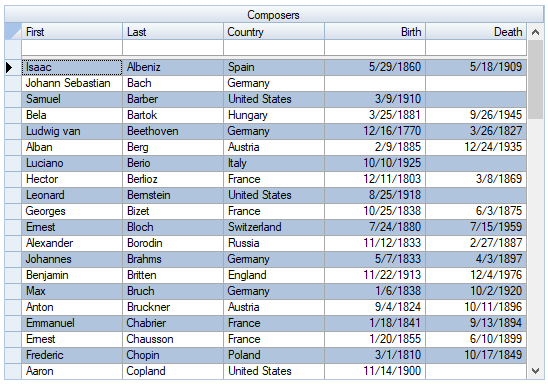- TrueDBGrid For WinForms
- True DBGrid Versus FlexGrid
- Key Features
- QuickStart
- Working with Objects and Collection
- Design Time
- Data Binding
- Columns
- Rows
- Cells
- Scrollbar
- Selection
- Split Presentation
- Sort
- Filter
- Merge
- Group
- Translate
- Incremental Search
- Views
- Export
- End User Interaction
- Customization
- RTL Support
- Appearance and Styling
- Best Practices
QuickStart
This quick start guide will walk you through the steps of creating a True DBGrid for WinForms application, binding the grid to a data source, and customizing the grid's appearance and behavior settings. You'll discover that you can easily create powerful database applications using True DBGrid for WinForms.
The quick start uses an Access database, C1NWind.mdb. The C1NWind.mdb database file is located in the Common subdirectory of the WinForms Edition program, the Documents\ComponentOne Samples\Common directory.
.NET
To create a simple WinForms application in .NET for True DBGrid control, complete the following steps:
Create a new Windows Forms application.
Add reference to C1.Win.TrueDBGrid NuGet package. Drag and drop the TrueDBGrid control from Toolbox to the form. Click 'Dock in Parent Container' option from the C1TrueDBGrid tasks menu.
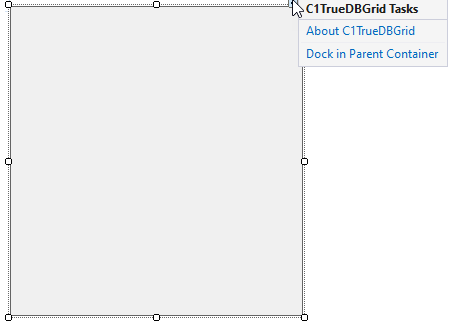
Create a sample datasource class 'DataSource'.
Bind the True DBGrid to this datasource using the DataSource property of the C1.Win.TrueDBGrid.BaseGrid.Frame class. This will populate the True DBGrid control with data.
//bind to data source var data = C1.DemoData.DataSource.GetRows("Select * from Data"); c1TruedbGrid1.DataSource = data;You can also customize the grid using the Caption, AllowAddNew, AlternatingRows and EvenRowStyle properties.
//customize TrueDbGrid c1TruedbGrid1.Caption = "Data"; c1TruedbGrid1.AllowAddNew = true; c1TruedbGrid1.AlternatingRows = true; c1TruedbGrid1.EvenRowStyle.BackColor = Color.LightBlue;Run the code and observe the output:
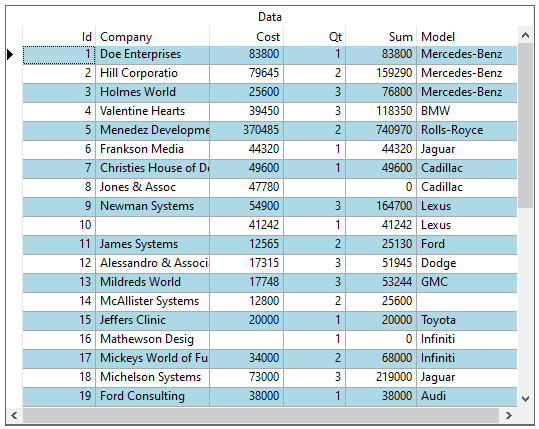
Note: WinForms .NET6 Edition does not include rich design-time support yet. We will enhance it in future releases.
.NET Framework
This section demonstrates how to create a TrueDBGrid application in .NET Framework by binding it to an external datasource using the TrueDBGrid Tasks menu. We will also learn how to customize the grid application using the Tasks menu.
Step 1: Creating a True DBGrid for WinForms Application
In this step you will add a C1TrueDBGrid control to the form and create a simple grid application. Complete the following steps:
Create a new .NET project.
Open the Visual Studio Toolbox and double-click the C1TrueDBGrid icon
 .
.The grid is added to the form and the C1TrueDBGrid Tasks menu appears.
In the C1TrueDBGrid Tasks menu, click Dock in parent container to dock the grid within the entire form. For more information on accessing the C1TrueDBGrid Tasks menu, see C1TrueDBGrid Tasks Menu.
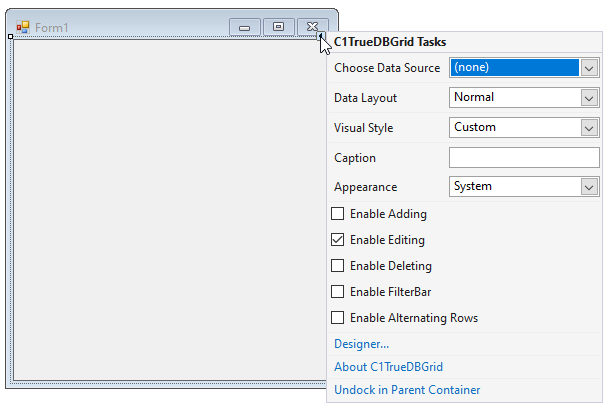
You've successfully created a simple grid application. In the next step, you'll learn how to bind the C1TrueDBGrid control to a data source.
Step 2: Binding True DBGrid for WinForms to a DataSet
In this step, you'll learn how to bind a C1TrueDBGrid control to a DataSet. You will also learn about the basic True DBGrid properties and observe the run-time features of the grid. Complete the following steps to bind a C1TrueDBGrid control to a DataSet:
Click C1TrueDBGrid1's smart tag to open the C1TrueDBGrid Tasks menu, select the Choose Data Source drop-down arrow, and click Add Project Data Source to add a new data source to your project.
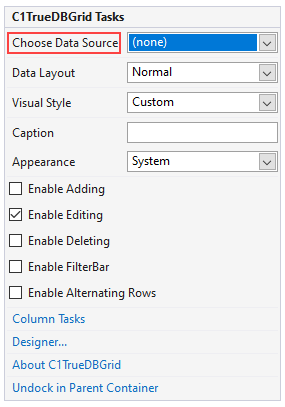
The Data Source Configuration Wizard appears and Database is selected. Click Next.
Click the New Connection button to locate and connect to a database.
Click the Browse button and locate C1NWind.mdb in the Documents\ComponentOne Samples\Common directory. Select it and click Open.
Click the Test Connection button to make sure that you have successfully connected to the database or server and click OK. The new string appears in the data connection drop-down list.
Click the Next button to continue. A dialog box will appear asking if you would like to add the data file to your project and modify the connection string. Click No.
In the next window, the Yes, save the connection as check box is checked by default and a name has been automatically entered in the text box. Click Next to continue.
In the Choose Your Database Objects window, you can select the tables and fields that you would like in your dataset. Select the Composer table.
The DataSet is given a default name in the DataSet name text box.
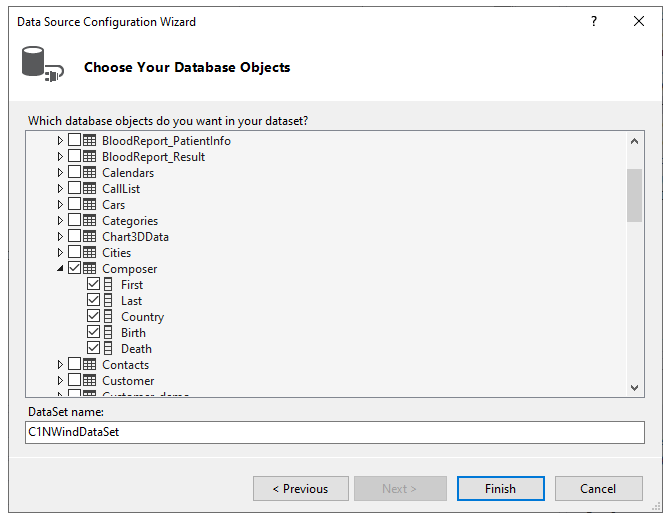
Click Finish to exit the wizard. The DataSet, BindingSource and TableAdapter now appear on your form.
Double-click the form. Notice that Visual Studio has added the following code to the Form_Load event:
this.composerTableAdapter.Fill(this.c1NWindDataSet.Composer);Run the program and observe the following:
Notice that the data from the Composers table is reflected in the grid:
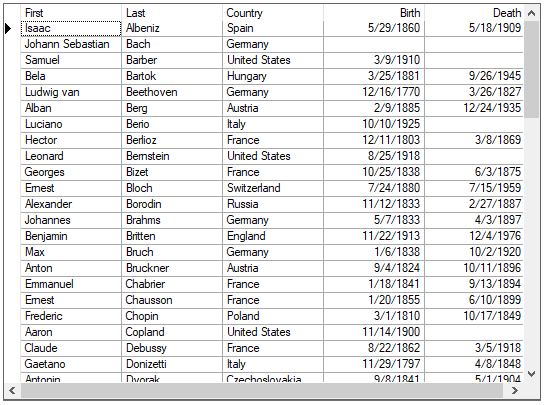
True DBGrid retrieves the database schema information from the DataSet and automatically configures itself to display all of the fields contained in the database table. Note that the field names are used as the default column headings.
Congratulations, you have successfully completed binding a C1TrueDBGrid control to a DataSet. In the next section you will customize the C1TrueDBGrid control's appearance and behavior settings.
Step 3: Customizing True DBGrid for WinForms Settings
In the previous steps you've added C1TrueDBGrid to a project, set up the grid, and bound the grid to a data source. In this step you'll customize the grid's appearance and behavior settings. Complete the following steps:
Switch to Design view and click on C1TrueDBGrid1's smart tag to open the C1TrueDBGrid Tasks menu.
In the C1TrueDBGrid Tasks menu set the following properties:
Set Caption property to "Composers" to add a caption to the grid.
Select the Enable Adding and Enable Editing check boxes to set the AllowAddNew and AllowUpdate properties to True and allow users to edit the grid.
Select Enable Alternating Rows to set the AlternatingRows property to True.
Set the VisualStyle property to Office2007Blue to set the grid's appearance.
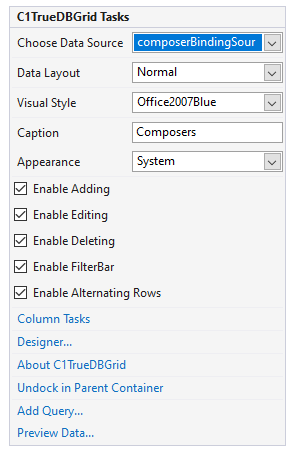
In the Properties window, set the EvenRowStyle.BackColor property to LightSteelBlue.
Run the program and observe:
You've customized the C1TrueDBGrid control. Notice that you've changed the appearance of the grid and can now add and edit the grid's content.
